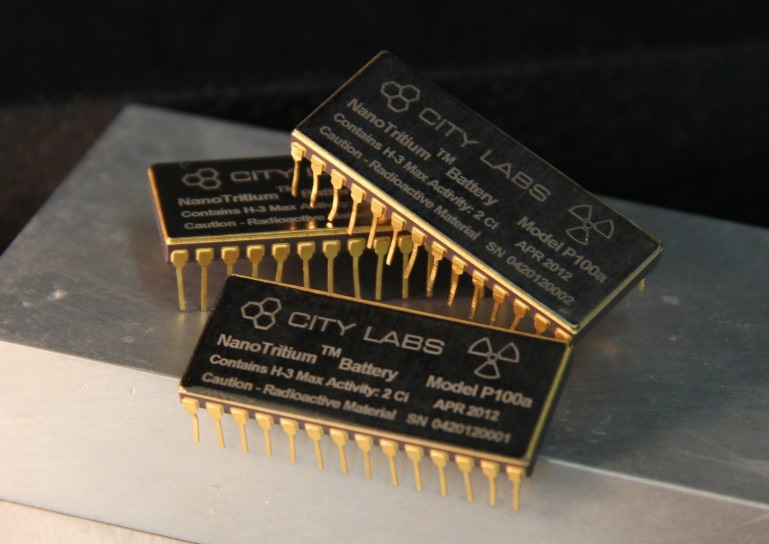I have mentioned nuclear batteries in past blog posts. They are especially useful for long term low power devices such as space probes or medical implants. Research into the betavolatic version of nuclear battery technology is over fifty years old. Early cardiac pacemakers used a nuclear battery based on promethium until lower cost lithium ion batteries became available.
Betavoltaics are a type of nuclear battery that utilizes beta particles (high energy electrons). In the conventional designs, the beta particles move through a semiconductor and produce an electric current. The semiconductor material in early betavoltaics was inefficient in producing electricity so high energy and dangerous radioactive isotopes had to be used. As time went by, better and better semiconductor materials were developed and less dangerous radioactive isotopes such as tritium could be used. There was still the problem with the slow degradation of the semiconductor material as it was damaged by the high energy electrons. As the semiconductor deteriorated, the production of electricity decreased.
In 2012, City Labs introduced its NanoTritium betavoltaic power source. This device is configured in the form of an electronic chip that can be plugged into a circuit board. The half life of tritium is about twelve years and City Labs says that it NanoTritium battery can provide energy to electronic devices for up to twenty years. It is sturdy and hermetically sealed with a solid form of tritium that should increase safety and reliability. It can withstand temperatures over a hundred degree Celsius range as well as severe vibrations and a large ranges of altitudes. The NanoTritium battery is the first commercially available betavoltaic nuclear battery for companies that do not have a license to handle radioactive materials. This will make it attractive for a much wider range of applications than the old betavoltaics. The current price of the battery is a few thousand dollars and that is expect to drop with increased production.
Recently, researchers at the University of Missouri announced the development of a new type of betavoltaic battery. Instead of being based on solid semiconductor material that was vulnerable to degradation, the new batteries utilize water. Water can absorb a great deal of nuclear energy, generating free radicals. These ionized versions of hydrogen, oxygen and water molecules make it possible to use the solution to generate power. The new battery utilizes a strontium-90 isotope. A titanium dioxide electrode with structures at the nano level and a platinum coating converts the electrochemical energy in the water into electrons that generate a flow of electricity.
These new betavoltaics could be game-changers for a number of industries as their features such as small size, high output, reliability, safety, cost and relaxed licensing make them candidates for power sources for a wider variety of devices. They could be a boon to medical equipment manufacturers who are constantly inventing new implantable devices that need small reliable long lived batteries.
